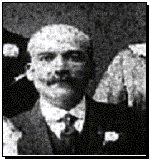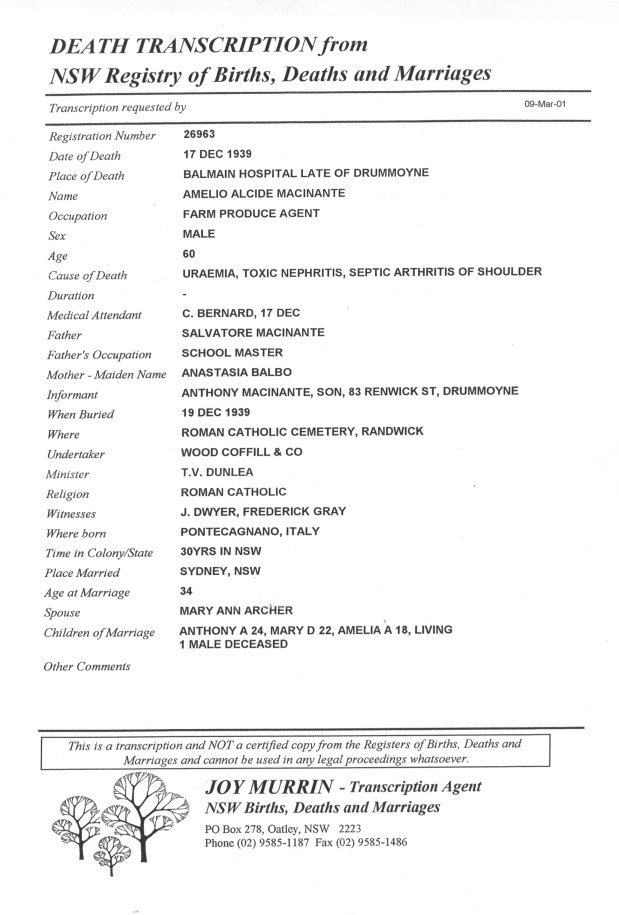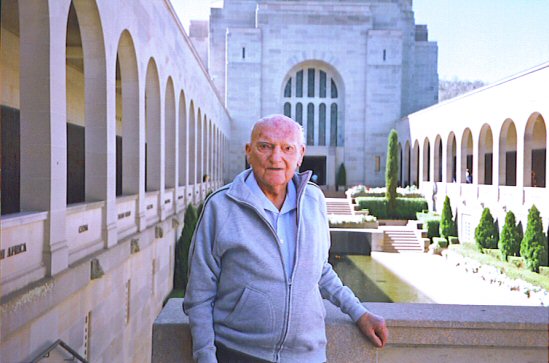1879 - 1939

|
Amelio Macinante 1879 - 1939 |

|

|
Anthony MacinanteHis Story - Precis by Peter CuddyOriginal in the Mitchell Library - Ref No. MSS5288Macinante ArchivesBorn on the 3rd September 1915, eldest son of Amelio Macinante, market gardener and his wife Mary (nee Archer) of the central Coast, NSW. Anthony grew up around Erina and Gosford in a farmhouse with two rooms and a big kitchen which was joined to the two rooms by a covered veranda. This he shared with his father's second cousin and his wife - Domenic and Giulia who had orchards. The farm was the centre of experiments for the agriculture department. Anthony's father was crippled in the left foot with polio. It was purported by Ann Cuddy that he was born with an unusually large left foot, e.g. a club foot. The family was well accepted in the region. They often came to Sydney and visited Uncle Candido and their many cousins'. Anthony left school (December 1929) at the age of 14 years and two months with the Intermediate Certificate. Many immigrants arrived at their door sent by the Italian Consul in Sydney and helped out by father. Early 1930 the fruit fly struck and devastated the crops and the land. Candido and Uncle Eddie helped out. Anthony went to work in Eddie's Barber Shop at Rose Bay. Then Anthony and his father went to work in the Fruit Markets. Father commenced work as a Produce Agent at the Sydney Markets as he could no longer work the land. They rented a cottage in Drummoyne, as the family had lost the farm to the Banks. In late 1935, Anthony got a "Deck Boy" job with the Adelaide Steamship Company. His first ship the "Aroona" (3000 tons) carried Coal, Iron Ore and Limestone from BHP. On the 15th January 1936 he changed jobs from "Deck Boy" to "Cadet Steward". On the 7th September 1937, he changed ships to be an Assistant Steward on the "Mundulla" carrying sugar from Cairns and other Queensland ports. Then trips to Western Australia. In August 1937, Anthony became a 1st Grade Steward and joined "MV Marella", a Burns Philip passenger ship, cruising the Pacific. Then on the 28th October 1937 he was on the "MV Manunda" a 9500 ton passenger ship on the Australian Coast. Then on the 22nd December 1938, Anthony transferred to "Katoomba" doing Pacific Cruises. He signed off the Katoomba in March 1939 and joined "Wanganella" on a "trade" trip to Hong Kong, Singapore and Batavia. Anthony left the "Wanganella" on the 14th April 1939 and joined its' sister ship "Westralia". Anthony enjoyed sea life. On the 3rd September 1939 war was declared and on the 27th September 1939, "Westralia" as with many other merchant ships was taken over by the Navy. HMAS Westralia was initially an Armed Merchant Cruiser and later a troop transport. (Jennifer Cuddy's uncle Owen Perkins also served on her). Anthony's stayed with family as his father was very ill. Father passed away on the 17th December 1939. Anthony tried hard to continue the business but eventually had to wrap up the family produce business. As the war continued to go on badly more volunteers were needed. Anthony joined the army on the 5th July 1940. After swearing in at the Victoria Barracks he was assigned to 2/7 Cavalry Regiment (7th Division), an armoured reconnaissance regiment and went to train at Ingleburn, assigned to Lt Sam Hordern's troop (of Anthony Hordern's fame). The troop went to Cowra for further training. In late December 1940, Anthony embarked on the "Queen Mary" and the 7th Division sailed in convoy for the Middle East and were fitted out in Egypt and Palestine. In Gaza, because he spoke fluent Italian, Anthony did some undercover field intelligence work and they visited Tel Aviv and Jerusalem, Bethlehem and other biblical places and then into front the line at Helwan in Egypt. With Greece falling, they embarked and they were landed in Cyprus in case Crete fell. In Cyprus they were attacked by German "Stuka" Dive Bombers and also the "Vichy" French in Syria and the Italian Air Force. After Crete fell, they were relieved and re-embarked for Palestine on the destroyer "HMS Havoc". They then joined the 7th Division Units to fight the "Vichy" French in Syria and Lebanon on the 8th June 1941. The fighting in Syria was intense but Anthony also found some time for some lighter moments and more "Field Intelligence" and was promoted to Corporal. In January 1942, they embarked on the SS Mendoza for parts unknown, being landed in Colombo. Then re-embarked on the liner "Orchades" and landed in Port Adelaide – "Home Again". But there was to be no home leave as they went straight into training camps in the Adelaide Hills, as Darwin was being bombed and the Japanese had taken Malaya and Singapore and the Dutch East Indies. They were moved overland by rail through Jerilderie NSW to Glen Innes where they got a welcome surprise – two weeks home leave and a great welcome home. Then it was off to Queensland and Jungle Warfare Training. Anthony then served in New Guinea in the Owen Stanley Range's, Popondetta, Dobodura, Seputa, Samanamda, and Cape Kilterton the battle experienced 6th and 7th Divisions were sent into the line to bolster up the hard pressed Militia Troops in July 1942. Anthony describes in detail the difficulties encountered and the horror of their comrades being killed and wounded but they had saved Australia. Anthony was repatriated back to Australia and came down with malaria in early 1943. Then after leave was again in Queensland under training in the 2/5 Field Company Royal Australian Engineers, then back to Port Moresby still as part of the 7th Division. They were involved in the famous Markham Valley Campaign. At the stroke of a pen, the 7th Division became an "Airborne Division" to invade Nadzab Airfield south of Lae. Anthony went through this, his second New Guinea Campaign, fighting at Nadzab, Lae Dimpu, Ramu Valley, Finistarre Ranges, Sliggy Ridge and Bismarck Ranges in conditions almost beyond human endurance. In March 1944 they were again repatriated back to Australia. Home leave once again. Then a move on to Wagga Wagga for retraining, reorganisation and off to Queensland. In April 1945 the 7th Division embarked for landings on Moratai and Balikpapan in Borneo. As Engineers they were involved in cutting wire and sweeping mines so that others could follow and in combat with a ruthless enemy up until the Japanese surrender on the 15th August 1945. Anthony then supervised Japanese POW's. He left the army on the 5th December 1945. Anthony re-entered the work force as a welder and married Jean Harvel (a former Air Force nurse) on the 13th April 1946 and became a fireman and engine driver at Balmain Power House (1949-1962). He then went to work for Union Carbide at Rhodes (1963-1965) and then F.J. Walker Waterside Cold Store Pyrmont (1965-1980) when he retired due to heart problems. An active Unionist, Anthony was a delegate for the Iron Workers' Union and the Engine Drivers and Fireman's Association. He contributed to the improvement of Workers' Awards and Conditions and the establishment of Shop Committees in various workplaces, always looking after the welfare of his colleagues. The End. |
 Anthony Macinante 1915 - 2007 |